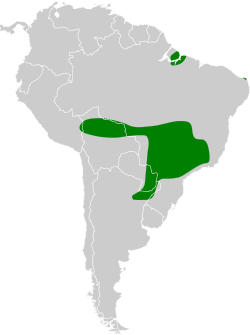| Black-masked finch | |
|---|---|
 | |
| Black-masked finch at Serra da Canastra National Park, Minas Gerais State, Brazil | |
| Scientific classification | |
| Domain: | Eukaryota |
| Kingdom: | Animalia |
| Phylum: | Chordata |
| Class: | Aves |
| Order: | Passeriformes |
| Family: | Thraupidae |
| Genus: | Coryphaspiza G.R. Gray, 1840 |
| Species: | C. melanotis |
| Binomial name | |
| Coryphaspiza melanotis (Temminck, 1822) | |
 | |
| Synonyms | |
Emberizoides melanotis (protonym) | |
The black-masked finch (Coryphaspiza melanotis) is a species of South American bird in the tanager family Thraupidae. It is the only member of the genus Coryphaspiza. It is found in Argentina, Bolivia, Brazil, Paraguay, and Peru. Its natural habitats are subtropical or tropical moist shrubland, subtropical or tropical dry lowland grassland, and subtropical or tropical seasonally wet or flooded lowland grassland. It is threatened by habitat loss.
